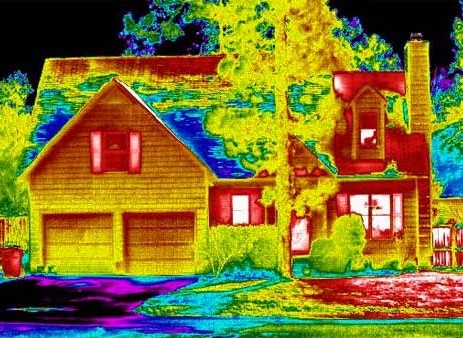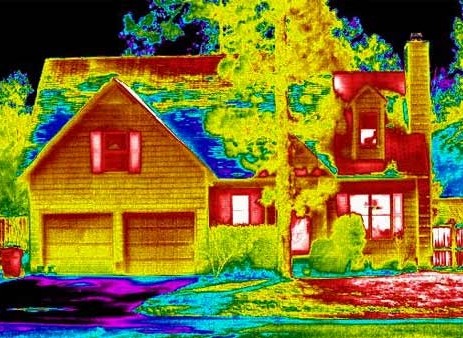 Thermal imaging helps energy inspectors locate heat leaks.Photo: reeishome.comWatching a skillful home-energy inspector explore a leaky house last week left me with a distinct sensation: envy.
Thermal imaging helps energy inspectors locate heat leaks.Photo: reeishome.comWatching a skillful home-energy inspector explore a leaky house last week left me with a distinct sensation: envy.
As the inspector went through the process, showing the homeowner how insulation, foam sealing, and other improvements would save money on heating bills, I realized I want some of that sweet weatherstripping action for my house. But my wife and I have a simple and common dilemma: we rent. We’re not going to pay for house improvements because we might not live there for long and won’t profit from the increased property value. Our landlord won’t shell out for much because he doesn’t pay heating and electricity bills — we do.
This renter’s dilemma is a real barrier to getting more homes weatherized (which, in case you haven’t heard, is a fan-flipping-tastic policy that helps out cash-strapped residents, saves energy, and creates building-industry jobs). Renters tend to have lower incomes, so they could use the savings more.
So I put out a call a few days ago asking for proposals for cracking this nut. Wouldn’t you know, some decent ideas came back. None of the proposals are a magic potion, which means it’s worth trying out a bunch of strategies. Starting with three steps tenants can take:
1. Talk to landlords about what they can do. Sounds obvious, but it’s an important place to start, and something not all energy-conscious tenants have done (guilty). A coworker got her landlord to pay for weatherstripping of doors simply by asking.
This may work for only the cheapest improvements. “Most landlords are looking for ways to recoup their electricity costs,” Tom Harrison of the efficiency products shop Energycircle.com told me. “A few say they want to help their residents conserve. And I don’t doubt them, but to be honest, of the several I have spoken with directly, they are all Canadian — seriously.”
2. Threaten to leave. If you’re a desirable tenant, owners might prefer to pay for some improvements than spend time and money looking for new tenants (The Alliance to Save Energy has a good list of specific improvements to consider.)
3. Ask about “green leases.” In this arrangement, an owner agrees to pays for improvements (say, $2,000 for attic insulation), then raises the lease ($50 a month) to recoup the cost. If the improvement saves an average $65 month in heating costs, the renter comes out ahead and the owner recovers the investment in a few years.
Commercial properties, where the energy bills and potential savings can be much higher, are leading the way with this model. It works better in theory than in practice. For one, it’s difficult to predict how much savings a set of improvements will create. Also, real-estate lawyers tend to be focused on closing deals, not taking a risk on some “green” model they’ve never heard of. So green leases haven’t gotten a lot of traction.
Now three steps that policymakers and utilities could take:
4. Ignore renters and weatherize owner-occupied housing first. This counterintuitive idea comes from David Goldstein, energy program co-director at the Natural Resources Defense Council. The U.S. needs home efficiency now, he says, so it should focus on the easiest target. As the weatherizing industry matures, it will develop trained workers, cost-saving innovations, and road-tested quality standards that it can then use to solve the tougher problem of rental housing.
5. Create an energy scoring tool — an MPG for buildings. Certain uncles of mine will ask how my car’s doing — including what mileage it’s getting — at holiday gatherings. An “MPG for homes” would encourage people to think and talk about home efficiency in the same way. Ratings would become a factor in housing searches in the way Walk Score has — which would encourage landlords to weatherize rental properties. There are several rating systems out there, including a new 1-10 Home Energy Score from the Department of Energy that may or may not be too simplistic. The key is for some rating system to become widely understood and trusted.
6. Institute on-bill financing. Perhaps the most promising tool. Utility companies pay for a retrofit, then recover the money by adding a surcharge to the home’s electricity or heating bill. For the renter, the lower energy cost balances out the surcharge — which is why this model has been marketed as “pay as you save.” (It works when the owner pays utilities too.) It’s a sister to the Property Assessed Clean Energy model, in which municipalities run the program and the surcharge is attached to property-tax bills.
Pilot programs in Kansas, Hawaii and New Hampshire have had success with the PAYS model, and it figures into the “green new deal” of the UK’s coalition government. The main holdup elsewhere has been utilities that say their billing systems aren’t equipped to handle this kind of financing. If that sound like a weak excuse … it is. The American utility industry, remember, spends less on R&D each year than the pet-food industry does. It’s going to take some prodding to get it to offer PAYS financing.
The keys, efficiency geeks have learned, are to make improving a home hassle free for residents, to remove the barrier of high upfront costs, and to make debt “stick” with a property– so if an owner sells or a renter moves out, the new tenant gets both the energy savings and the remaining payments. On-bill financing would do all of these. It’s worth trying out.



